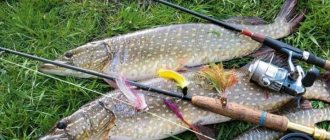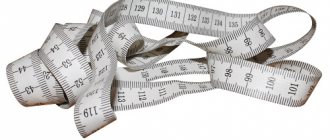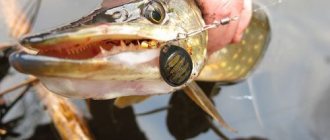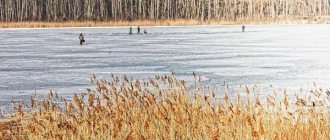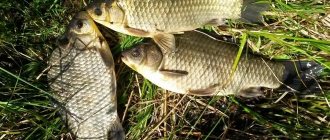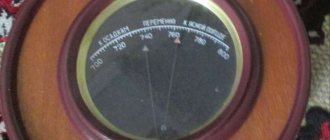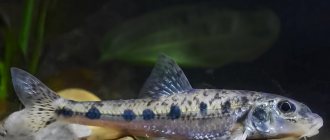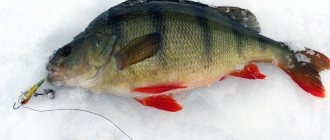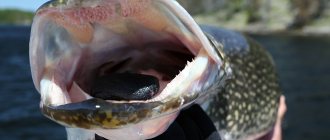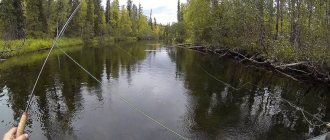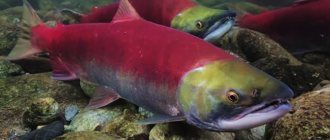Minnow fishing
very popular among fishermen.
The gudgeon is one of the few fish in fresh water whose behavior and condition can be used to judge the quality of water in a particular body of water. It thrives in clean water and completely disappears from bodies of water where the water is polluted. That is probably why this fish is a desirable catch for any fisherman. The gudgeon
is a numerous small non-commercial fish that is readily caught by amateur fishermen. The appearance of this small fish is more or less known to everyone; it is easily recognized by its large scales, cylindrical body and two small antennae that lie at the corners of its mouth. In quite rare cases, gudgeon reaches 20 cm in length and thickness of the thumb, as, for example, in the middle Volga; for the most part it is no more than 13 cm.
Content
- 1 Description and lifestyle
- 2 Habits and habitats
- 3 Features of gudgeon fishing
- 4 Methods of catching gudgeon 4.1 Catching gudgeon in a wade
- 4.2 Fishing for minnows
- 4.3 Fishing for gudgeon with a self-submersible float
- 4.4 Float rod for catching minnows
- 4.5 Fishing for gudgeon with a side nod and jig
- 4.6 Donka and half-bottom for catching gudgeon
- 5.1 Fishing for gudgeon in summer
General fishing questions
Where to look for gudgeon in a pond
A uniform distribution of gudgeon is observed in small rivers with active currents, where the bottom is predominantly sandy. Most often, the gudgeon stays at the bottom of shallow water in order to merge with the surface and not be caught by a predator.
In a reservoir, uneven bottoms, the foot of sand dunes, and small dumps act as catching places. In such places, the current twists in different directions, forming eddies of water that bring all kinds of garbage and food.
The mobility of the school is low, but the gudgeon rarely stays in the same places. Today in one place you can catch several dozen scoring minnows, and tomorrow there will not be a single bite in the same territory. The gudgeon is also located next to the dace, the capture of which foreshadows the bite of our fish.
What gear is used to catch gudgeon?
A light float rod with a length of 3 to 6 m is perfect for catching minnows. We choose the thinnest fishing line, as well as a lightweight plastic or feather float with high sensitivity. For the worm we choose a standard size hook No. 6, for bloodworms - No. 4.
When the gudgeon is actively biting, we equip the tackle with two hooks, one of which should be located 4-7 cm higher using a short leash.
Minnows are also caught in winter. Its activity at this time of year is accompanied by the presence of warm sluices and open water in the reservoir. As tackle we use any winter fishing rod, a small hook and bloodworms. We choose the most sensitive nod for a winter fishing rod. The depth for fishing for gudgeon in winter is 1-3 meters on small currents with a sandy bottom.
Advice! When casting, the tackle adjusts the depth so that the hook barely touches the bottom, and in some places even lies.
What time of day is best to fish?
The gudgeon is most active during the day. At this time, in search of food, the gudgeon stays near the illuminated areas of the reservoir in shallow water. At night, the gudgeon sinks to depth and does not show activity.
Baits and lures
In the summer, worms, maggots, caddis flies, bloodworms, jigs, bread crumbs, pearl barley, semolina and other vegetable baits are actively used as bait. In winter, they most often use bloodworms or maggots with a light and small jig, and the gudgeon is not picky about the characteristics of the bait during this period - it can be a single-color or multi-colored jig with bloodworms, maggots, jigs, worms or plant baits.
Fishing in winter
The onset of frost forces the fish to move to the pits, so the activity of the fish decreases slightly. To search for gudgeons in the winter, it is advisable to know in advance places with a sandy bottom. On a small river, the depth of the gudgeon's habitat is average.
To determine the bottom topography, we drill several holes at a distance of 3-5 meters from each other. Steep banks, river bends, and depressions in the area of rifts are the most preferred sites for gudgeon. Most often, the gudgeon stays in the coastal zone, therefore, the middle of the reservoir will not give positive results.
If, after summer fishing, the water area of the coastal zone is well known - the presence of snags, the beach, depths of no more than 2 meters - this will only be an advantage, since it is in these places that the largest accumulation of minnows is observed in the winter.
How to catch with a trap
A liter or two liter plastic bottle (depending on the diameter of the drill) and a string are suitable as a trap.
1. One of the bottles is cut into 2 parts 5-7 cm above the bottom;
2. On the sides of the cut bottom part of the bottle we make small holes with an awl or a needle in the amount of 10 pcs. This is necessary to ensure that the water drains. In the middle of the bottle we make holes with a width of 0.5 cm in quantities of up to 5 pieces;
3. We make a handle using a string or thick fishing line, which we thread through wide holes in the lower cut part. We tie the ends. This is how we will pull out the trap;
4. Cut off the neck from the second part of the cut bottle just below the bend line;
5. Remove the lid from the cut neck;
6. We insert the neck of the bottle with the outer conical side into the lower part of the bottle with a handle;
7. For fixation, use electrical tape, wrapping the edges of the two parts;
8. As bait, we use a piece of bread, which must be placed in the trap, crumble it into pieces with a diameter of 2-3 cm. To ensure that the plastic sinks and does not float up, add a little sand or gravel;
9. We lower the trap to the bottom of the reservoir into a drilled hole where a school of gudgeon is supposedly located.
Be sure to tie a rope or thick fishing line to the handle to pull the feeder. The gudgeon will be caught through the neck of the trap behind the bait, and after a while we pull out the trap.
Jigs for catching minnows in winter
Before choosing a jig, pay attention to the nod test. The most optimal version of nod with dough is 1 g. The most catchy forms of jigs are droplets, pellets, crescents and ants. There is a great variety in the choice of jigs, since the gudgeon is not picky about the type of jig. The main thing is that its weight does not exceed 2 grams.
We use minnows as live bait
The gudgeon is characterized by its widespread use as live bait, both in winter and summer. Any predatory fish can be caught with gudgeon, of which the most common are pike perch, pike, and perch. Such live bait does not tolerate prolonged exposure to warm, slow-flowing water and quickly becomes unusable. You can also catch chub or burbot using gudgeon.
How to hook
There are different ways to bait a minnow as live bait. The classic method of baiting is to hook the minnow on a treble hook about 3 cm below its fin, so as not to damage the ridge - this way the baitfish will stay active longer. The second method is to insert live bait through the gills, which completely eliminates the occurrence of injuries. Unfasten the hook from the leash. We pass the leash through the gills of the minnow so that it comes out completely through the mouth. We fasten the double and pull the leash so that the hook rests on the baitfish’s mouth.
Description and lifestyle
Gudgeon Gudgeon
is a small fish with an elongated, ridged body covered with large scales. The mouth is lower, arched, with one antennae at the corners. The lower lip is widely interrupted. The snout is long, twice the diameter of the eye. The eyes are relatively large.
The coloring is typical bottom, providing good camouflage on dark ground. The back is gray-brown, the sides are light, yellowish in large individuals. On the sides of the body there are about 10 large dark spots along the lateral line. The dorsal and caudal fins are gray-yellow, with rows of small dark spots, the remaining fins are colorless. The caudal fin is noticeably cut out.
The gudgeon reaches the age of 8-10 years, but rarely exceeds 3 years, a maximum length of 20 cm and a weight of 226 g, but the usual size is no more than 12-15 cm. Females are larger than males.
The gudgeon becomes sexually mature when it reaches a length of 8 cm. It breeds at night in spring and early summer (April-June), when the water warms up to 15°C. Spawning is portioned, on the current, in shallow places with a rocky-sandy bottom. Eggs with a diameter of 1.3-1.5 mm. stick to the ground. Fertility 1-3 thousand eggs. The eggs take about 8 days to develop. Larvae and fry eat plankton and other small invertebrates. The juveniles stay close to the shore, and as they grow, they move to deeper places.
Minnow in winter
photo: Anatoly Mailkov
In all seasons, gudgeon was and is considered the best bait for catching various predatory fish with live bait gear. It seems that this is especially important in the middle of winter, when it’s time to set up bait stations for burbot, and in the dead of winter it’s unlikely that pike perch can be tempted to bite with anything else - here the gudgeon has no competition as a live bait. In addition, many people consider minnows fried in breadcrumbs until crunchy in vegetable oil to be a gourmet food; An excellent cold appetizer would be sprats prepared at home from gudgeons, but for this you need to catch at least two or three kilograms of fish, which is very, very difficult to do, and not possible everywhere, although it is the winter gudgeon that is the most delicious, as, indeed, ruffe, roach and many other fish.
So where and how to catch minnows of the required size and in sufficient quantities during freeze-up? First of all, of course, on a small river with a noticeable current, riffles and a hard sandy or rocky bottom, although in large rivers there is a lot of this fish, but there it is more difficult to find concentrations of gudgeon, and here is a paradox - in large reservoirs gudgeons are generally much smaller than in some narrow streams only two or three meters wide. The only thing you need to keep in mind when going to a fast river in winter is the dangers that lie in wait on its ice, because the thickness and quality of the ice cover here strongly depend on the depth at the fishing site and the speed of the flow, as well as on the nature of the current winter season.
As a rule, in winter, schools of minnows stay in a more moderate current than in summer, when they often occupy the rapids themselves on the riffles. From the ice, it is better to catch them on relatively short reaches between the rifts, where the depth is flat and is approximately 1-1.5 m, and the bottom is sandy, slightly “littered” with organic matter and with islands of aquatic vegetation. Here, by the way, the ice is more reliable, without any special surprises. In the selected fishing area, it is better to make holes closer to the middle of the reach, where the current is stronger, and not far from the upper rift. The holes do not need to be darkened - the gudgeon is not bothered by the light, this allows you to sometimes observe how the fish is approaching, and, depending on its activity, choose fishing tactics, focusing on a particular type of tackle.
Fishing with a jig is often impossible, since a noticeable current requires the use of a heavy bait - a gudgeon with rare agility will remove bloodworms from it, completely ignoring the hook, no matter how miniature it may be. Therefore, the best effect is achieved by using rigs with an end weight in the shape of a drop or a ball corresponding to the force of the current and a leash located above it with a hook or an extremely light jig, sometimes with a body made of colored plastic. It is advisable to select a weight of such weight that when lowered to the bottom, it will be carried away from the vertical by the current at approximately an angle of up to 30 degrees. This way the tackle will be the most sensitive, since when biting the main impact will be on the line above the load. The catchability of the tackle as a whole is determined by its harmonious construction: the optimal ratio must be found between the length of the leash, depending on its load (hook or jig) and the thickness of the fishing line, and the distance at which this leash is installed from the sinker. For catching minnows on a leash, a piece of fishing line with a diameter of 0.08 - 0.10 mm, a length of 25 cm (with a jig weighing up to 0.3 g) or up to 40 cm (with a hook No. 20-16, according to international numbering), installed on at a distance of 8-12 cm from the sinker. You can attach the leash to the main fishing line with a diameter of about 0.12 mm without additional elements - using the “loop to loop” method.
As a reliable bite alarm, a sensitive guard made of a narrow steel or lavsan plate is usually used, the length of which should be no more than 80 mm, otherwise there will be many delays in hooking after quick bites of the gudgeon. The elasticity of the guard should correspond only to the force of the current, but not at all to the weight of the equipment as a whole - installed above the hole, due to the pressure of water on the fishing line, it will bend somewhere at an angle of 40-60 degrees to the surface, thereby meeting the condition of maximum sensitivity.
When the sinker is lowered to the bottom, the tackle is not installed under tension, and the main line is given a slack of 10-20 cm, which is taken out by the current. This way the leash gets some additional free movement when biting, which will be reflected in the guard. If the tension in the fishing line is not eliminated, the gudgeon, feeling resistance, will throw the bait or tear off the bait with impunity. This is due to the nature of the bite of a gudgeon living in running water: in a short throw, grabbing the food with strong lips, it takes it into its mouth while moving.
As winter bait when fishing for minnows, they usually use one large bloodworm, placed in a half ring on a thin hook with a long shank, or two or three feed bloodworms, attached in the usual way. If the current allows you to fish near the bottom with a small playing jig, then in addition to bloodworms you can also attach a burdock moth larva or small maggot.
When fishing for minnows in the current, bait is important because it allows you to pull in fish from considerable distances, significantly increase its concentration under the hole and ultimately increase biting activity. For obvious reasons, bait lowered to the bottom should produce abundant turbidity from very small particles of food, carried far away by the current. On the river, it is better not to empty the feeder at the bottom, but to install it on the bottom soil through an additional hole drilled about half a meter above the working one. As the contents are washed out through the perforations on the walls of a regular cone feeder, it should be recharged from time to time with a portion of pre-moistened food. To stimulate the bite of inactive fish, sometimes you can make a “volley” release of food - slightly raise the feeder and shake it several times in the water column. This method significantly saves bait and does not satiate the minnows. Of course, the best bait is bloodworms, but if you use it according to the usual pattern, then the nimble and voracious gudgeon will very quickly become saturated with a subsequent deterioration in its bite on the fishing rod. In addition, if there is a “threat” that in a given section of the river a lot of perch, ruffe, roach or dace may gather on bloodworms, then it is better not to use live food at all.
| photo: Anatoly Mailkov |
When using bloodworms for bait, you can proceed as follows: first deep freeze it until it becomes “glassy”, then place it in a feeder and literally crush it into powder with your finger. The feeder is also placed on the bottom, where the contents slowly thaw and wash out, creating an attractive stream that reaches far away. You can do it differently: crush a portion of small bloodworms or several large larvae on a cotton swab or on a piece of foam rubber, which are then placed in a small metal capsule with holes, tied to the fishing line instead of the end sinker. This method is very effective and significantly reduces the consumption of live food.
If there is no bait, then to attract minnows to the fishing site, you can use the old “old-fashioned” method, which is usually used in summer wading fishing, that is, from time to time stir up the bottom soil, creating a muddy stream. This is done with a stick through a hole drilled a meter and a half upstream from the place where the gear is installed.
Since the gudgeon is a purely bottom-dwelling fish, the technique for catching it is not very diverse. When using gear with a leash, it should be periodically slowly lifted from the bottom and just as slowly lowered back. This simple game, which creates the effect of food slipping away or floating near the bottom, often causes an immediate, confident bite by the fish. You can also play with a jig in the current by shaking it rhythmically almost at the same level near the very bottom, but without lifting it up, and this game alternates with tapping the bait on the bottom.
The nature of the gudgeon's bite in the current depends on its activity and the density of fish under the hole and is very diverse. The bite is reliable when the guard is confidently pressed down - in this case there are almost no empty hooks. If the bite is bad, when the gudgeon is overfed or the equipment is too heavy, you can observe either “ruff” shaking or neat “roach” clamps at the guardhouse. If you do not take measures to activate the bite, then such fishing will turn into torture with a low final result. The best thing here is to reduce the weight of the equipment, the thickness of the line and the size of the bait to the limit, and also replace the passive expectation of a bite with working with the gear, because winter fishing for any small fish has its own specifics, often its success depends on nuances that are not so significant when hunting for more respectable inhabitants of reservoirs.
If caught minnows go to the table, it is better to immediately remove them from the ice into a bag and store them in a fishing box so that they do not freeze too much in frosty weather - the culinary qualities of any fish noticeably suffer from this. Minnows intended for live bait are, of course, carefully removed from the hook and lowered into a canna with water, which is insulated as far as possible, for example, buried deep in loose snow, so that the fish does not experience sudden changes in temperature and maintains high vitality.
Anatoly Mailkov February 15, 2011 at 16:01
Habits and habitats
The gudgeon is a widespread Eurasian species with a fragmented range. It is found from Portugal to the Amur basin and the rivers of the northwestern coast of the Sea of Japan. In Russia, it is common in reservoirs of both the European (with the exception of the Kola Peninsula and North Karelia) and Asian parts. Not recorded east of the Yenisei, its range is interrupted here. The gudgeon reappears in the Amur basin and in the Tugur, Uda, Suifun and Tumannaya rivers; it is absent in the rivers of the Pacific slope located north of the Amur and Uda, in Kamchatka and Sakhalin. In Mongolia it is found in the Onon, Kerulen, Khalkhin-Gol rivers and in Lake Buir-Nur. Available in China (Yalu and Liaohe rivers). It is no longer available in Japan.
Minnow distribution map
The gudgeon lives in lakes, in the lower reaches of slow-flowing rivers, and in the upper reaches of fast-flowing rivers. It is found even in slightly salty waters of the Northern Baltic. Stays near the bottom. In summer it forms small accumulations in shallow water, in winter it moves to depth. It feeds on the larvae of chironomids, mayflies, caddis flies and other insects, as well as crustaceans and mollusks (peas), and in the spring it readily eats the eggs of other fish.
Does not like cold and fast-flowing water. It lives in small schools at depths of 30 to 150 cm, and only gathers in schools during spawning.
The gudgeon's favorite places are small holes behind the rifts if the current is strong, and on the rift if it is weak. In early spring, when the water on the river is still cloudy, the gudgeon rises into rivulets and even streams - they brighten earlier. In the fall, as the water gets colder, it goes to deeper places, and in October - November (depending on the weather) it hides in deep holes and pools for the winter. You can hardly find him among the grass, and if he wanders there, it is only at night, when he comes here to hide from enemies. In general, this is a purely daytime fish.
Where to catch gudgeon in spring in April and May
It is good to catch gudgeon near the dam, where there is a noticeable current pull, as well as on the rocky-sandy bottom below the dam. Thus, on the Tsaritsyn Ponds, a lot of minnows are found in the area of the spillway of the Upper and Lower Pond dams. At the same time, for their habitat, schools of minnows often choose depressions on the bottom in the form of holes and ditches away from a strong stream or below the main stream, where a fast current turns into a slow one.
In the second half of May you can successfully catch gudgeon in small tributaries. To do this, the fisherman wears a wading suit or high boots into the water, standing above the gudgeon’s habitat, and picks up mud from the bottom. The gudgeon usually quickly gathers on a fast stream, so it is caught with a short fishing rod using a short retrieve of the bait. This kind of fishing can be exciting.
Read also: With a feeder for May bream
Peculiarities of gudgeon fishing
Minnow fishing
begins immediately after the opening of rivers, lakes, ponds and continues until the onset of frost. The greatest gudgeon bite is observed in early spring. According to fishermen, at this time up to 150 fish can be caught from one place.
The summer activity of the gudgeon occurs mainly in the evening and morning dawns. But at night the gudgeon does not take it, because, as already mentioned, it prefers to lie down in the lower layers. In late autumn (November), the gudgeon goes to winter and hides in thickets of aquatic plants. But, despite this, it is also possible to catch it in winter: during the cold season, gudgeons are best caught in the deepest places. The peak bite intensity occurs when the external waters become clear.
Fishing for minnows The main fishing for minnows occurs during daylight hours, since they are a daytime fish. From the morning until about lunchtime, fishing for minnows is more productive, but in the afternoon, the activity of the fish weakens significantly. The main condition when catching gudgeon is to raise the soil that has settled to the bottom, for which turbidity is artificially created. In such “no light” the gudgeon moves fearlessly and at this moment it can be caught almost with a net.
In addition to the fact that the gudgeon takes bait especially well in the morning and evening hours, it also bites well after rains, when the water in the rivers is forced to become cloudy. Its bite is very decisive, often with the sinking of the float. However, when hooking a gudgeon, you must be extremely careful and not sweeping - this will prevent the fish’s lip from being torn by the hook, and it will not slip into the water.
The choice of bait for catching minnows depends on the fishing location. On riffles, the bite is more successful if you put a piece of a red worm or a common ironworm on the hook, which is even better. In quiet and calm places, it is preferable to fish with a whole worm (in extreme cases, half).
They also use bloodworms, which they take from 2 to 3 pieces, hooking them below its head. This attachment is ideal for a float rod and when fishing closer to autumn. At the same time, fishing for medium-sized worms is effective: when catching a gudgeon at depth, a whole worm is used, while in shallow waters, half of it is used. In spring, summer and the second part of autumn, it is best to use dung worms as bait. Gudgeons do worse on plant-grain baits, just like they do on ant eggs and maggots.
The most suitable baits for catching minnows are a medium-sized worm (small), caddis fly, and bloodworm. They are good at any time of the year. In summer you can also use wheat and steamed barley. For complementary feeding and bait, bloodworms and chopped worms are optimal, and bread is extremely rare.
How to choose a place and what to catch minnows with
Cool flowing water bodies with a hard bottom (sand, stone, pebbles, clay) can be considered promising for fishing. Sandy shallow waters, rocky river riffles, well-heated pits and dumps at moderate depths are optimal for gudgeon fishing.
The gudgeon will only bite on bait of animal origin. As for bread, dough, cereals and other vegetable attachments, they are of little use.
The iron ore worm can be considered a universal bait, but since it is included in the Red Book of the Russian Federation, it is better to abandon this idea and use other baits.
The gudgeon is well caught on bloodworms, maggots, honeydew and caddis larvae, and dung worms. The first two are planted either individually or in a bunch of several pieces. It is best to use the worm in sections, without forming a tail that hangs down too long.
Fishing for gudgeon does not require bait. The exception is earthen balls with the addition of chopped worms and bloodworms, which, when released into the water, create a cloud of turbidity that attracts fish.
But in general, the gudgeon presents great deviations both in color (old ones are always darker) and in the shape of the body and head. It has been noticed that in the northern parts of Russia the gudgeon is much sharper than in the south; in Moscow province. All fishermen distinguish it from the ordinary black minnow.
But in general, the gudgeon presents great deviations both in color (old ones are always darker) and in the shape of the body and head. It has been noticed that in the northern parts of Russia the gudgeon is much sharper than in the south; in Moscow province. All fishermen distinguish it from the ordinary black minnow.
However, on the rifts the gudgeon hides behind rocks, and... rises upward here with pushes from one defense to another.
In Western Europe, especially in France, where the gudgeon enjoys great respect, much more than in our country the ruffe and even the burbot, these methods, very simple and handy, are very common. Firstly, a lot of gudgeons are caught here with special small and frequent small capes, which are thrown from a boat or a deep bank, after first stirring up the water with a pole or oar. But for us the game is not worth the candle; This fishing is difficult, and it is unlikely that anyone in Russia will catch such a small thing this way.
They are caught on the rise - from locks, bridges, especially floating ones, gangways and rafts, less often by wading and from boats. Before lowering the net to the bottom, the water is strongly stirred up - this is necessary, since the turbidity is, as we will see later, the main bait for the gudgeon.
There, instead of tops, they use very original equipment, namely horse and bull skulls, which are immersed in water at certain places. Minnows enter the skull through the occipital foramen and, when quickly rising, do not have time to get out.
As for the time of day, the gudgeon, like a daytime fish, takes the bait only from sunrise to sunset, and with the onset of darkness the biting stops. It takes best in the early morning shortly after sunrise. It bites the worst during the day, especially in hot weather. The state of the weather seems to have a small influence on the intensity of the bite of this fish, but before bad weather you will never catch many of them. On the contrary, after rain, when the water becomes somewhat cloudy, the gudgeon takes more greedily.
Tips for fisherman: How to lure crucian carp to the fishing spot in summer - Detailed review
The bait is mainly either a dung worm or a bloodworm: the first - in spring and summer, the second - in autumn, from August. In quieter places it is better to fish with a whole worm or half; on riffles, it is more profitable to plant a piece of a red worm or, even better, a piece of an ordinary iron ore worm, like a ruff. Bloodworms are attached, as always, by threading the hook tip below the head, in the amount of 1-3 pieces.
As for other baits, they are of little use for catching this fish. Not only do minnows not take any kind of bread bait (however, I once caught 2 minnows on bread in Lake Beloe), but they are not particularly willing to grab, for example, maggots and ant eggs; The latter is more likely to be caught by bluets than blacks.
However, the small bluegill, which has a relatively small mouth, bites relatively very sluggishly, hesitantly and often sucks bloodworms, which is why fishermen, if they catch a bluegill, immediately change their place.
The gudgeon is a very tenacious fish and is almost irreplaceable as bait for predatory fish. In Western Europe it is considered an excellent food fish for salmon, and in England it is often kept for a long time in troughs and baths. When using the described blowing devices, minnows can be transported over considerable distances.
In our country, gudgeons are mostly used for fish soup, and often together with ruffs, since fish soup made from minnows alone, almost devoid of mucus, is not very rich. Less often, minnows are eaten in a frying pan with sour cream. The French are big fans of minnows fried in onions or crushed breadcrumbs, in Provençal butter. Gudgeon soup is a very light and digestible food and is given even to feverish people. Minnow meat is white and somewhat sweet. Lake gudgeon, especially pond gudgeon, always smells somewhat like mud.
In this article you will learn what is good about fishing for gudgeon, as well as the features of fishing and what this tasty river fish bites on.
Methods for catching minnows
As you know, gudgeons are caught using float and lead rods. However, the decisive factor is the bait, which allows you to achieve the greatest success. In winter, they use a float rod or jig to catch minnows.
Catching gudgeon in a wade
To attract a gudgeon to a place, you don’t need excessively strong tricks - just stir up the soil that has settled at the bottom of the reservoir. This method of catching gudgeon is called wading. It consists of the fact that the fisherman enters the water in the traditional habitat of the fish (for minnows these are areas above the riffles) and muddies the water with his feet. In the resulting “suspension,” the minnows rise upward and may even touch the fisherman’s boots.
Fishing for minnows
For this kind of gudgeon fishing, take the lightest fishing rod with a small hook and a small float. You can also fish for gudgeon using a half-bottom fishing rod. A pellet of the required mass is selected as a load. They catch with such gear in the wiring. The depth is set by eye, making sure that the bait drags straight along the bottom. Any stop of the float is responded to with a soft hook. With this method of catching gudgeon, stirring up the water with your feet or a pole is also suitable.
Catching gudgeon with a self-submersible float
A similar method of catching gudgeon is practiced in shallow water with fast currents. Since the gudgeon is predominantly a bottom-dweller, it is best to keep the bait at bottom level. Particularly active bites are observed when the bait is dragged along its surface. Often, 2 hooks are used on a fishing line: the lower one is placed 5-10 centimeters from the upper one, which is tied on a short leash.
Float rod for catching minnows
Catching a gudgeon by retrieving does not always bring success, since it is so lazy that it will not take off and pursue a quickly floating bait. Therefore, fishing with a line without touching the bottom with a sinker is practiced only in quiet areas of water, where there are a lot of gudgeon and he waits for the food to swim straight into his mouth. If a minnow notices that a tasty morsel is slipping away, it can pursue it for a short distance. When the fish is standing on a fairly fast stream, it makes sense to fish the retrieve by dragging the nozzle and sinker along the bottom. The length of the leash should not exceed 10 cm. It is better to choose a pear-shaped float with a slightly larger carrying capacity than usual, so that it does not dive when the equipment hits a pebble or sand, but continues to drag the sinker, leash and hook with a nozzle along the very bottom in the current . In this case, stopping and slightly lowering the float is a signal of a gudgeon bite.
On the shallows of lakes and ponds with little current, the length of the leash may be slightly longer, and the float will be suitable with a narrower body. Since gudgeon fishing almost always takes place in shallow water, where the fishing depth rarely exceeds 2 m, when rigging a float rod, I always use one weight element attached close to the leader, if necessary. However, when you fish with the sinker and bait dragging along the bottom, there is a risk of snagging. Then you need to use a leash made of a thinner fishing line to avoid losing the entire line. If you fish on pond shallows free of grass and snags, then you can easily do without a leash.
Catching gudgeon with a side nod and a jig
Tackle structure with a side nod and a jig This light and mobile tackle, consisting of a telescopic rod 4-5 m long, a foam reel “filly”, a long nod, a piece of fishing line with a diameter of 0.15 mm, the length of the rod and a jig, is convenient for fishing gudgeons in sections of the river with currents of different speeds.
When playing the bait “on the rise”, minnows rarely pursue it. Considering that gudgeons in fast currents like to stand behind small water obstacles, it is worth lowering the jig to the bottom behind the stones. If the fish stand behind each other in the stream, bites may follow one after another. To activate a school of minnows, it is useful to lightly stretch the jig along the ground, keeping the line taut, and then return it to its original position, that is, make the bait freeze in a lull behind some pebble. It is better to use small or very small jigs with a hook No. 16-18. The best attachment for a jig is a piece of a small worm. Small fish with a bad bite fiddle with the bait for a long time or only tug at it, so it is very important to catch the moment to hook.
Donka and half-bottom for catching gudgeon
On various types of donkeys, gudgeons are caught along the way when catching other fish. Sometimes it will grab the worm when you fish on vast sandbanks or rocky rifts. However, donka is a rough tackle for gudgeon, sometimes you don’t even see a bite. You just take out the equipment to recast, and a small fish hangs on it. You can catch a gudgeon with a half-bottom more purposefully.
The fishing line for minnow half-bottoms (taking into account the rocky bottom or other catchy places) must be set with a diameter of at least 0.14 mm; leash - 0.12 mm. The float should not be too heavy, but such that under its weight, taking into account the strength of the current, a slight sag of the fishing line is formed, which allows you to notice any, even the weakest bite. It is best to catch a gudgeon with a half-bottom when it is completely calm. If the wind is blowing and the current is uneven, a weak gudgeon bite may not be noticed at all.
Tackle and bait
The fish itself is small, so thin equipment is required, otherwise there will be rare bites or there will be none at all. For winter fishing for minnows, you should purchase a separate winter fishing rod for small species of fish, which includes minnows.
The bait used is a jig, which weighs about 0.2 grams. The fishing line used is 0.06-0.7mm in diameter. Such gear will ensure effective fishing for winter gudgeon. Coarser gear is not required. Make sure that the jig has a small thin sharp hook - No. 18-20. For bait, use bloodworms. It is a thin hook that allows you to attach a bloodworm well, which on such a hook will be active for quite a long time, attracting minnows.
In principle, in winter, gudgeons go well with a baitless jig or other types of bait, but the most effective way to catch gudgeon in winter is with a jig with bloodworms. A winter fishing rod for gudgeon should be chosen with a sensitive nod: the gudgeon is a small fish, it is quite possible to miss a bite. During a winter bite, the nod sharply drops down, and almost always such a bite is followed by a successful hook.
Thus, when preparing winter equipment for minnows, you should not forget that it is necessary:
- take about 0.2 g of jig;
- use thin fishing line, with a diameter of 0.06-0.07 mm;
- take a thin small hook No. 18-20;
- choose a fishing rod with a very sensitive nod;
- Use bloodworms for bait.
Post by garbar76 » Nov 17, 2014 1:53 pm
Gudgeon
Post by Sinigr » 01 Apr 2014, 12:24
Re: Minnow
Post by skvoznyak » Jun 09, 2014, 11:29 am
Re: Minnow
Post by garbar76 » Nov 17, 2014 1:53 pm
Re: Minnow
Post by Old » 11 Jan 2015, 20:36
Re: Minnow
Post by Zoya » Jan 24, 2015, 00:04
Re: Minnow
Post by alexis1977 » Jan 25, 2015 03:48 pm
Re: Minnow
Post by k0mp0t » Jan 26, 2015, 7:35 pm
Tips for fisherman: How to properly equip a float rod for crucian carp - How to best use
Re: Minnow
Post by k0mp0t » Jan 26, 2015, 7:41 pm
The gudgeon is a small and nimble fish, a typical inhabitant of rivers and flowing reservoirs. Despite its small size, the gudgeon is very popular among fishermen: thanks to its vitality and mobility, it is one of the best live baits for catching predatory fish species. In addition, it has an excellent taste when fried or dried, and gives a unique taste and aroma to the fish soup made from it.
The gudgeon is a small and nimble fish, a typical inhabitant of rivers and flowing reservoirs. Despite its small size, the gudgeon is very popular among fishermen: thanks to its vitality and mobility, it is one of the best live baits for catching predatory fish species. In addition, it has an excellent taste when fried or dried, and gives a unique taste and aroma to the fish soup made from it.
The choice of bait for fishing depends on the season: • In spring, on rivers with medium and strong currents, the gudgeon actively bites on pieces of dung worms and shitik; • In summer, in addition to worms and shite, you can catch gudgeons using steamed vegetable baits such as wheat and pearl barley; • In the fall, just before the cold weather, the gudgeon better takes 2-3 bloodworms on a hook. This fish has little or no success with maggots, chafer larvae, and ants. Tackle
To catch gudgeon in the open water season, use a simple summer float rod, consisting of a 5-meter carbon fiber Bolognese rod, a small bobbin or spinning reel, fishing line with a cross-section of 0.14 mm, a float with a weight of 0.5-1.0 g, 15- 20 cm leash made of monofilament 0.12 mm thick with hook No. 10-12.
In winter, however, as in the period of open water, gudgeon leads a diurnal lifestyle. With the onset of night it becomes motionless and settles down on the surface of the bottom. Fish activity increases during the thaw. During the freeze-up period, it feeds on the remains of aquatic vegetation and invertebrate bottom larvae. It rarely rises to higher levels of water: only to escape from active predatory fish.
Seasonal features of gudgeon fishing
Fishing for gudgeon in summer
Fishing for gudgeon with summer fishing rods begins in April and usually ends in October. In summer it bites throughout the day, better in the morning and evening dawns. The equipment is the lightest. For small rivers this is usually a pioneer fishing rod. In any case, with a fishing rod longer than 4 m, it can be difficult to turn around in coastal vegetation.
On larger rivers, as well as on lakes and reservoirs, they fish with light carbon-fiber rods 4–6 m long. The fishing method is reeling or half-bottom, from the shore or wading. The main line is 0.1–0.12 mm. Leash 0.08–0.1 mm. A float with a carrying capacity of 1–2 g, can be feather or foam. Hook No. 13–18 with a long shank. It is better to equip the half-bottom with two hooks. Bait - bloodworms (three or four larvae per hook), caddisfly, maggots, underleaf worms, earthworms (usually only part of the worm is baited). When fishing with pellets of bread or dough, you need to take a hook with a short shank and hide it completely in the bait.
If you want to catch a sufficient amount of gudgeon, then you need to use bait. I usually use steamed millet, to which I add ground oats, so that the balls of bait are slightly washed away by the current. It’s good to add ground seeds and a little bloodworm there. As bait, you can use clay balls with pieces of worms rolled into them. The gudgeon is also suitable for ordinary streams of turbidity. For this purpose, you need to periodically pick the bottom at the fishing spot with a stick.
On forest rivers, where thickets of coastal bushes and trees interfere with fishing with a fly rod, gudgeons are caught with a summer fishing rod with a side nod and a jig. For fishing in the wilds of the forest, a fishing rod with a nod should be designed as simply as possible. To store a supply of fishing line, a small reel is used, which is mounted on the knee next to the whip. When moving along the shore, the rods are folded to the length of the line (1–1.5 m), the line itself is pressed against the rod so that it does not cling to the branches, the jig is held in the same hand as the rod. When a suitable fishing spot is found, the assembled fishing rod is pulled out over the water, the jig with bait is released and then the legs are pulled out one after the other.
The gudgeon also takes on bottom gear installed near fast jets. The design of the donkey can be of any type. Often minnows are caught when fishing with bottom rods for other fast-water fish that love rocky sandy bottoms, such as whiteeyes.
On medium and large rivers, gudgeons sometimes sit on a hook when fishing with side rods. Of course, bait, scattered with balls of mixture or lowered to the bottom in a net, plays a big role here. Any peaceful fish, including gudgeon, is suitable for bait. It is advisable to have leashes equipped with snap hooks on the side fishing rods; then, if necessary, you can change leashes with large hooks to smaller ones, minnow hooks. On some rivers in the fall, gudgeons gather in huge schools, sliding into not too deep holes in the riffles. Here he continues to feed, and if you get to such a place, you can become the owner of an excellent catch (considering that the fried gudgeon has an excellent taste and its bones are soft).
Fishing for gudgeon in winter
Fishing for gudgeon in winter Most often, gudgeon is caught in the summer, but by the way, you can successfully catch it in winter.
In addition, gudgeon is an excellent live bait for catching many predatory fish. Catching large minnows is also very interesting, which is far from uncommon in our reservoirs. Therefore, we will talk in more detail about winter fishing. Of course, she does not need any special preparation, but, nevertheless, there are some nuances. The principle of fishing is as follows: the angler makes a hole, which will be the main one, and several more are made around it, so that the main hole is in the center. We lower a light feeder with bait into this central hole, and throw ordinary winter fishing rods into the rest. The fishing rod should be equipped with the thinnest possible equipment - a fishing line with a diameter of no more than 0.12 mm, a light float or a sensitive nod and a small hook with an elongated fore-end. We use small bloodworms as bait, and catch them with larger ones.
In winter, gudgeon can also be caught with jig tackle. For this purpose, the lightest jigs are used, such as a pellet, a nymph or an ant. As noted, the best results are shown by gray and black jigs.
The game is usually played in slow motion, near the bottom. For example, these can be careful movements, with long pauses, as well as smooth oscillations at the moment when the jig comes off the bottom and rises 10-15 cm. Also, instead of a jig, you can use a hook with a pellet sinker, or a worm or bloodworm as an attachment . They fish with this kind of gear without playing, simply by placing the fishing rod on the ice. However, if there are no bites for a long time, then you can play along a little.
If during fishing the bite begins to weaken, then it is recommended to throw a little food bloodworm into the hole; if fishing is in a weak current, then a feeder is not necessary here, you can simply sprinkle bloodworms into the hole.
In general, it is best to catch gudgeon in winter in places where there is at least some movement of water. In this case, the bait will move at least somehow, which will naturally attract the attention of the fish.
In bodies of water with medium or fast currents, the gudgeon often stays near various water obstacles. In this case, the bait sinks to the bottom behind the obstacle and if there is a gudgeon there, then the bites will follow one after another. And in order to collect a school of minnows, you can lightly drag the bait along the bottom and then return it to its original position.
Features of appearance, habitat and fishing
Half a century ago, minnows could be caught in large numbers in all rivers, small rivers and streams, but these days the population of this fish has noticeably decreased. Although the gudgeon is primarily a river dweller, it can be caught in reservoirs and flowing lakes.
In the summer months, these aquatic inhabitants love to eat, and the rest of the time they like to hide in their shelter houses from predatory fish, preferring solitude. The best bait for gudgeon fishing is a worm, and the best tackle is a regular float rod
The gudgeon is a very small fish, weighing only a few tens of grams and no more than fifteen centimeters in length. Minnows have a gray-green back with black dots, a dark stripe on the sides, the scales are dense, the body looks like a bar with a pair of mustaches hanging from the lips.
Gudgeon
This fish lives only in clean water. In the summer, fishermen look for it on the rifts, near sandy shallows, and in the fall - in deeper places. In winter, minnows sleep in reservoirs or river holes.
But in the last two decades, winters have become very warm, and therefore gudgeons are successfully caught in winter, both in open water in non-freezing reservoirs and from ice on small rivers in shallow water.
After the spring flood of rivers, the return of reservoirs to the banks begins; it is on these days that the gudgeon begins to spawn. The spawning of this fish is unusual: the eggs emerge from the fish within 1-1.5 months, in several stages. A distinctive feature of gudgeon caviar is its light blue tint.
Baby minnows begin to live on sand spits, feeding on insects there, but most of the baby minnows become food for perches. When catching predatory fish species, the gudgeon is considered one of the best live bait, since its body is convenient for a predator to swallow, and the live bait itself remains alive on the hook for quite a long time, unlike bleaks, which quickly become dead.
Minnow minnow is a good bait for catching predatory fish
Often gudgeons are used as live bait for summer baits and bottoms. You can fish for gudgeon from morning to evening, as it loves daylight very much. But with the onset of twilight, minnows move to their holes and spend the night there, motionless, so as not to become prey to a nocturnal predator.
